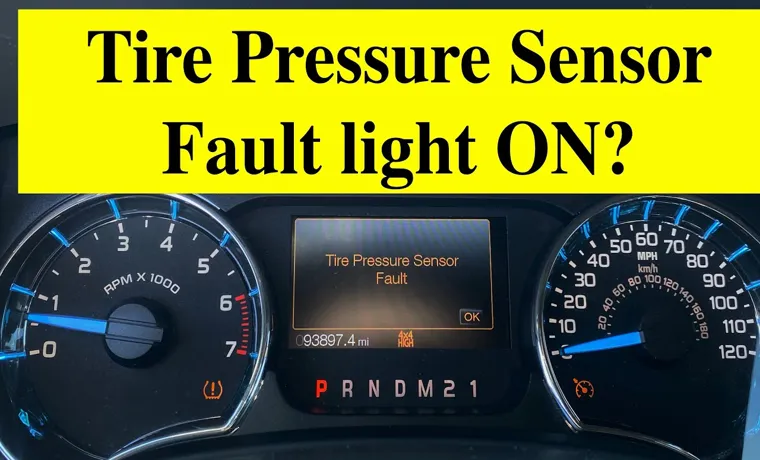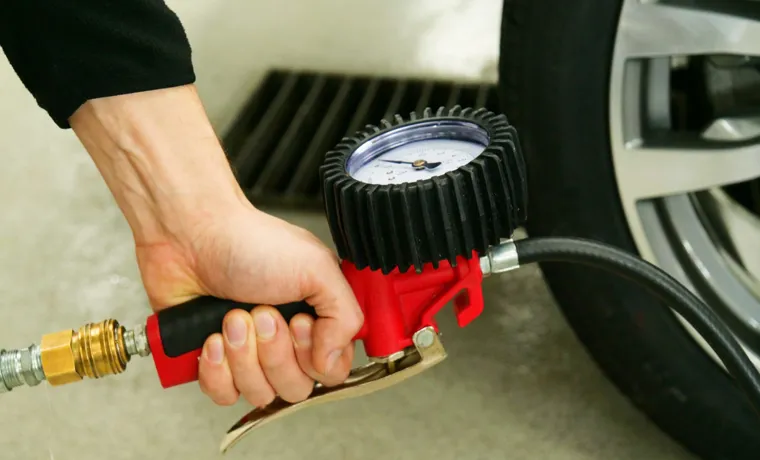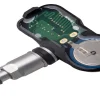Do you ever feel like your car is speaking a different language when it flashes a dashboard warning? One warning that can be particularly puzzling is a tire pressure sensor fault. Luckily, this is a common issue that can be fixed with a few simple steps. Keep reading to learn how to troubleshoot and resolve a tire pressure sensor fault.
Just like a pesky splinter, this problem can be a small nag, but it can cause some serious issues if ignored. So, let’s get to the bottom of it and get your car back on the road with confidence.
Table of Contents
Understanding Tire Pressure Sensor Faults
If you’re experiencing tire pressure sensor faults, you may be wondering how to fix them. The first step is to confirm that it is indeed a sensor fault and not a physical problem with the tire or valve stem. Once you’ve determined that the sensor is the issue, there are a few potential solutions.
The simplest fix is often to reset the sensor by driving the vehicle for a short distance, although this may not always work. If the sensor still shows a fault, you may need to replace it entirely. Depending on the vehicle and the location of the sensor, this can be a simple or complex process.
However, it’s important to address the issue and ensure that your tire pressure monitoring system is functioning properly to maintain safe driving conditions.
Causes of TPMS Faults
Tire Pressure Sensor Faults Tire Pressure Monitoring System (TPMS) is a vital safety feature that provides drivers with real-time information about tire pressure. However, like any other component in your vehicle, the TPMS may experience faults that can lead to a malfunctioning system. The most common cause of TPMS faults is a dead or low battery in the sensor.
This is usually indicated by a dashboard warning light that appears as a yellow exclamation point. Another possible cause is when the sensor loses communication with the On-Board Diagnostic (OBD) system, mostly due to a broken or disconnected wire. Furthermore, inaccurate tire pressure readings may occur due to environmental factors such as extreme temperature changes or tire punctures.
It’s essential to understand that these faults compromise the TPMS’s accuracy and reliability, which can result in decreased fuel efficiency, premature tire wear, and even hazardous driving conditions. Therefore, it’s vital to have your TPMS checked regularly by a professional technician to avoid any potentially dangerous driving situations.

Types of TPMS Faults
TPMS Faults If your car’s TPMS warning light comes on, it’s likely that one of your tire pressure sensors is not working properly. There are several types of TPMS faults that can occur, such as sensor failure, low battery, communication failure, and even physical damage. Sensor failure is the most common type of fault and can be caused by a variety of factors, including corrosion, sensor damage, and electrical problems.
Low battery faults occur when the sensor’s battery dies, and communication faults occur when the sensor fails to communicate with the car’s ECU. Physical damage can also cause TPMS faults, such as when the sensor is damaged in an accident or by hitting a curb or protrusion. Understanding the different types of TPMS faults can help you diagnose and fix the problem quickly, which can help you avoid more severe consequences, such as tire blowouts and accidents.
Symptoms of TPMS Faults
If you’re experiencing issues with your vehicle’s tire pressure monitoring system (TPMS), there are a few common symptoms to watch out for. One of the most obvious is a warning light on your dashboard indicating low tire pressure, which could be caused by a faulty sensor. Another sign of a TPMS problem is inaccurate tire pressure readings displayed on your vehicle’s information system.
You may also notice unusual tire wear, reduced fuel efficiency, or even strange noises while driving when there is an issue with the TPMS. It’s important to address these symptoms early on to prevent any larger issues with your tires or vehicle operation. If you suspect there is a problem with your TPMS, take your vehicle to a trusted mechanic to have it inspected and potentially repaired before it can cause any further damage.
How to Fix a TPMS Fault
If you’re driving along and your tire pressure monitoring system (TPMS) light comes on, don’t panic! This warning light indicates that there is a potential issue with one or more of your tire pressure sensors. The first thing you should do is pull over and check the pressure on each tire with a tire pressure gauge. If you find that the pressure is low, inflate your tires to the recommended PSI.
If the pressure is correct, you may need to reset your TPMS using a scan tool or by disconnecting the battery for a few minutes. If your TPMS warning light remains on, it may be time to visit a mechanic to diagnose and fix the underlying issue. Whether it’s a faulty sensor or a wiring issue, a qualified mechanic will be able to identify and solve the problem.
Remember to make sure that your TPMS is functioning properly, as this system is designed to keep you safe on the road.
Check Your Tire Pressure
Maintaining the proper tire pressure is vital to ensuring the safety and longevity of your vehicle. However, sometimes the Tire Pressure Monitoring System (TPMS) can malfunction, resulting in a fault code being displayed on your dashboard. But fear not, fixing a TPMS fault can be easy.
Check your tire pressure manually with a tire pressure gauge and fill any tires that are underinflated. If this does not resolve the issue, it may be a sensor or wiring problem, and a mechanic should be consulted. Remember to always check your tire pressure regularly, as a faulty TPMS can lead to decreased gas mileage, tire wear, and even dangerous blowouts on the road.
Keep yourself and your vehicle safe by staying on top of your tire pressure maintenance.
Reset Your TPMS System
TPMS system Resetting your TPMS system is not as complicated as it may seem. Start by checking your vehicle’s manual as it will contain the specific information needed to reset your TPMS system. Depending on the make and model of your vehicle, there are different ways to reset your TPMS system.
Some might require a simple press and hold of a button, while others may require a technician to use a diagnostic tool. Whether it’s a DIY solution or professional aid that you need, it’s important not to ignore TPMS faults as they can lead to unsafe driving conditions, decreased fuel efficiency, and costly repairs. Resetting your TPMS system can help improve your vehicle’s performance and contribute to overall road safety.
Replace Faulty Sensors
If you’ve been dealing with a TPMS fault, the solution might be as simple as replacing faulty sensors. TPMS sensors are responsible for collecting tire pressure information and transmitting it to your vehicle’s onboard computer. When a sensor fails, it can cause the TPMS light on your dashboard to come on, signaling that there’s a problem with your tire pressure monitoring system.
The good news is that replacing a faulty sensor isn’t a complicated process. You just need to identify which sensor is causing the problem and replace it with a new one. While it may be tempting to try and fix a sensor on your own, it’s best to seek professional assistance to ensure that the replacement process is done correctly.
By replacing the faulty sensors, you’ll have a functioning TPMS system that’s vital for maintaining your car’s safety and performance.
Preventing TPMS Faults
If you’ve ever had a tire pressure sensor fault, you know how frustrating it can be. Fortunately, there are things you can do to prevent these issues from occurring in the future. One of the most important things you can do is to make sure that your tires are properly inflated at all times.
This will help to prevent damaging the sensor, which is often caused by underinflated tires. In addition to this, you should also make sure that your tires are free from any damage or debris that could cause the sensors to malfunction. Regularly inspecting your tires and ensuring they are in good condition will go a long way toward preventing TPMS faults.
If you do experience a sensor fault, it’s important to get it fixed right away to ensure your safety on the road. By taking these preventative measures, you can help to ensure that your TPMS system functions properly and you are able to avoid any unnecessary headaches or expenses.
Regularly Check Your Tire Pressure
If you want to keep your tire pressure monitoring system (TPMS) running smoothly, it’s essential to check your tire pressure regularly. This simple task can help prevent TPMS faults and other tire-related issues. Keeping your tires properly inflated can also improve your safety on the road, increase fuel efficiency, and extend the life of your tires.
So, take a few minutes once a month to check your tire pressure using a pressure gauge or a digital tire pressure monitor. And don’t forget to inflate your tires to the recommended PSI (pounds per square inch) level, which you can find in your vehicle owner’s manual or on the tire itself. By taking this small step, you can avoid costly repairs and keep your TPMS functioning at its best.
Avoid Overloading Your Vehicle
When it comes to preventing TPMS faults, one of the most important things you can do is to avoid overloading your vehicle. Overloading can cause a range of problems, including putting extra stress on your tires and causing them to wear out faster. Additionally, heavy loads can cause your tires to become heated, which can lead to tire failure and a potential blowout on the road.
To avoid overloading your vehicle, it’s important to keep track of the weight of both your cargo and your passengers to make sure that you’re not exceeding the recommended weight limits. By taking care to avoid overloading your vehicle, you can help ensure that your TPMS system stays in good condition, helping you stay safe on the road. Remember that prevention is always better than treatment when it comes to your TPMS system, so taking care of your vehicle’s weight limits is essential.
Conclusion
In conclusion, fixing a tire pressure sensor fault is like solving a mystery – it requires a little bit of investigation, a touch of technical know-how, and a sprinkle of patience. The first step is to determine which sensor is at fault and then check for any physical damage or interference. If all looks good on the surface, it’s time to dig a little deeper and scan for any error codes.
Once you’ve identified the issue, it’s usually a matter of replacing the faulty sensor or recalibrating the system. With these simple steps, you’ll be back on the road with a fully functioning tire pressure monitoring system in no time, and who knows, maybe you’ll even feel like a tire pressure detective!”
FAQs
What is a tire pressure sensor fault and how does it occur?
A tire pressure sensor fault is when the sensor fails to accurately measure the air pressure in the tire, resulting in a warning light on the dashboard. It can occur due to a variety of factors, such as damage to the sensor, low battery power, or interference from other electronic devices.
Can a tire pressure sensor fault be ignored?
It is not recommended to ignore a tire pressure sensor fault as it can lead to potential safety hazards and reduce the overall performance of the vehicle. It is important to have it diagnosed and repaired as soon as possible.
How can a tire pressure sensor fault be diagnosed?
A tire pressure sensor fault can be diagnosed by using a diagnostic tool to check for error codes. The sensors can also be visually inspected for damage or signs of wear.
Can a tire pressure sensor be repaired or does it need to be replaced?
It depends on the extent of the damage. In some cases, a tire pressure sensor can be repaired by replacing the battery or resetting the sensor. However, if the sensor is severely damaged, it may need to be replaced.
How much does it cost to fix a tire pressure sensor fault?
The cost of fixing a tire pressure sensor fault can vary depending on the make and model of the vehicle, as well as the extent of the damage. It can range from around $50 to $250 for a single sensor.
Can I fix a tire pressure sensor fault myself or do I need to take it to a mechanic?
While it is possible to fix a tire pressure sensor fault yourself, it is recommended to take it to a mechanic who has the necessary tools and expertise to diagnose and repair the issue.
How can I prevent a tire pressure sensor fault from occurring?
To prevent a tire pressure sensor fault, it is important to regularly check the air pressure in your tires and ensure that they are properly inflated. It is also recommended to avoid driving over rough terrain or hitting potholes, which can damage the sensors.



